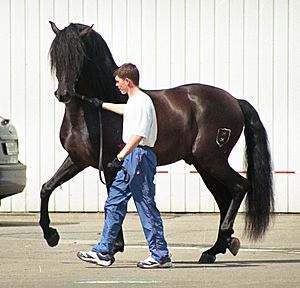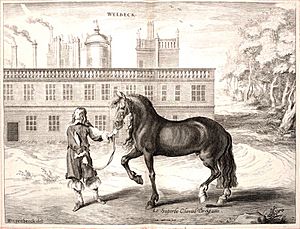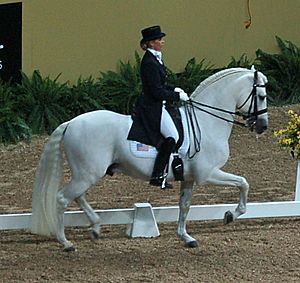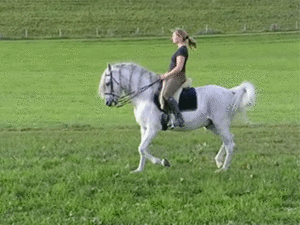Andalusian horse facts for kids
The Andalusian is a beautiful horse breed from Spain. It is also called the Pure Spanish Horse or PRE (which stands for pura raza española). This breed comes from the Iberian Peninsula, where horses have lived for thousands of years. The Andalusian has been known as its own special breed since the 1400s. Its body shape has stayed almost the same for centuries.
Throughout history, the Andalusian was famous as a war horse. Kings and nobles loved these horses. The Spanish government even used them to make friends with other countries. Kings all over Europe rode and owned Spanish horses. In the 1800s, wars, sickness, and mixing with other breeds greatly lowered their numbers. Even though they recovered a bit, their population stayed low into the early 1900s. Spain did not allow Andalusians to be exported until the 1960s. Since then, the breed has spread worldwide. In 2010, there were over 185,000 registered Andalusians around the globe.
Andalusians are strong and elegant horses. They have long, thick manes and tails. Most Andalusians are gray, but they can come in many other colors. They are known for being smart, sensitive, and gentle. There is a special group within the breed called the Carthusian. Breeders think this group is the purest kind of Andalusian. However, scientists have not found genetic proof for this idea. Still, Carthusian horses are often sold for more money.
The Andalusian horse is closely related to the Lusitano from Portugal. It has also helped create many other horse breeds. This is especially true in Europe and the Americas. Many European warmblood breeds have Andalusian ancestors. Breeds like the Azteca in the Americas also have Andalusian blood. For centuries, Andalusians were chosen for their strength and endurance. They were first used for classical dressage, driving, bullfighting, and as stock horses. Today, Andalusians are used in many horse riding activities. These include dressage, show jumping, and driving. They are also often seen in movies, especially historical and fantasy films.
Contents
What Makes Andalusians Special?
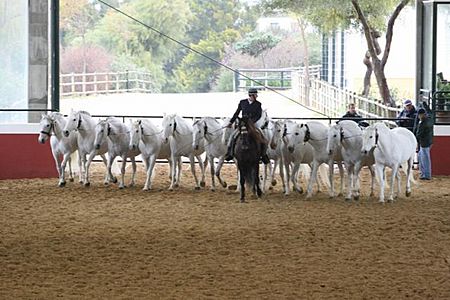
Andalusian male horses (called stallions and geldings) are about 15.1 hands tall. They weigh around 1,129 pounds (512 kg). Female horses (called mares) are about 15 hands tall. They weigh around 908 pounds (412 kg). In Spain, a male horse must be at least 15 hands tall to be registered. A mare must be at least 14.3 hands tall. These rules are followed by the main Spanish horse associations. For a horse to be considered "qualified" for breeding, stallions must be at least 15.1 hands. Mares must be at least 15 hands.
Andalusian horses are elegant and strongly built. Their heads are medium-sized, with a straight or slightly curved nose profile. Very curved or very dished profiles are not preferred. Their necks are long and wide, leading to a strong chest. They have a short back and strong hindquarters. Their legs are clean and healthy. They have energetic gaits (ways of moving). Their manes and tails are thick and long. However, their legs do not have a lot of long hair (feathering). Andalusians are usually gentle, smart, and sensitive. They learn quickly and are cooperative when treated well.
There are a few unique traits in the Carthusian group of Andalusians. These traits are believed to come from an old stallion named Esclavo. One trait is small warts under the tail. Some breeders thought this showed a horse was from Esclavo's family line. Another trait is "horns," which are small bumps on the forehead. These might come from Asian horse ancestors. However, these "horns" are not used to prove a horse's family line.
In the past, Andalusians came in many different colors, even spotted. Today, most Andalusians are gray or bay (reddish-brown). In the US, about 80% of Andalusians are gray. About 15% are bay, and 5% are black, dun, palomino, or chestnut. Other colors like buckskin, pearl, and cremello are rare. But they are allowed by the breed registries.
Long ago, some white markings or hair swirls on a horse were thought to bring good or bad luck. For example, a horse with no white markings was thought to be ill-tempered. Certain face markings were seen as signs of honesty or loyalty. Hair swirls in different places also had meanings. Two swirls near the tail were a sign of courage and good luck.
Andalusian horses move in a special way. Their movements are big, high, and graceful. They balance roundness with forward motion. Poor movement or irregular steps are not desired. Andalusians are known for being agile. They can quickly learn difficult moves, like advanced collection (a way of riding where the horse carries itself with great balance). A study in 2001 compared Andalusian, Arabian, and Anglo-Arabian horses. It found that Andalusians lift their legs higher when trotting. This elevated movement helps them be successful in riding and dressage.
A 2008 study found that Andalusians can have certain health issues. They are more likely to have problems with blood flow to their small intestine. Male Andalusians also have a higher chance of getting inguinal hernias. This risk is 30 times higher than in other breeds. However, they have fewer problems with their large intestine. The study also showed Andalusians had the highest risk of laminitis (a painful hoof condition) linked to gut issues.
Andalusian Horse History
How the Breed Started
... the noblest horse in the world, the most beautiful that can be. He is of great spirit and of great courage and docile; hath the proudest trot and the best action in his trot, the loftiest gallop, and is the lovingest and gentlest horse, and fittest of all for a king in his day of triumph.
The Andalusian horse comes from the Iberian horses of Spain and Portugal. Its name comes from Andalusia, a region in Spain. Cave paintings show horses lived on the Iberian Peninsula as far back as 20,000 to 30,000 years ago.
Over time, many different groups of people influenced Iberian horses. These included the Celts, Carthaginians, Romans, Germanic tribes, and Arabs. The Iberian horse was known as a skilled war horse as early as 450 BCE. Studies show that Andalusian and Barb horses (from North Africa) crossed the Strait of Gibraltar. They bred with each other, mixing their bloodlines. This means the Andalusian might have been the first European "warmblood." It was a mix of strong European horses and lighter Oriental horses.
Some of the oldest written family records for horses were kept by Carthusian monks. They started these records in the 1200s. Monks were good at reading and writing. So, nobles often asked them to manage horse breeding. Andalusian breeding farms were set up in Carthusian monasteries in the late 1400s. These were in places like Jerez de la Frontera, Seville, and Cazalla de la Sierra.
The Carthusians bred strong horses for the Spanish Crown. They used the best Spanish Jennets as starting horses. These horses were a mix of Jennet and warmblood types. They were taller and stronger than the original Jennets. By the 1400s, the Andalusian was its own breed. It was used to help develop other breeds. They were also great cavalry horses. In the 1600s, William Cavendish called the Spanish horse of Andalusia the "princes" of the horse world. He said they were "unnervingly intelligent."
The Iberian horse became known as the "royal horse of Europe." It was seen in many royal courts and riding schools. By the 1500s, during the reigns of Charles V and Phillip II, Spanish horses were the best in the world. Only wealthy people could own quality horses in Spain. In the 1500s, horse prices became very high. The Andalusian was already expensive and became even harder to buy.
Spreading Around the World
The Spanish government also used Spanish horses to make friends with other countries. They gave horses and export rights to favored citizens and other royals. By the 1400s, the Spanish horse was common around the Mediterranean Sea. It was also known in northern Europe, though it was rarer and more expensive there. Over time, kings across Europe had paintings made of themselves riding Spanish-type horses. French kings like Louis XIII and Louis XIV especially loved Spanish horses. In 1600, a French horse expert said the Spanish horse was the most perfect. He called it "the most beautiful, noble, graceful and courageous."
Spanish and Portuguese war horses came to England in the 1100s. Imports continued through the 1400s. In the 1500s, Henry VIII received Spanish horses as gifts. He got them from Charles V and others when he married Katherine of Aragon. By 1576, Spanish horses made up one-third of British royal horse farms. The Spanish horse was most popular in Great Britain in the 1600s. Horses were freely imported and exchanged as gifts between royal families.
After the mid-1700s, interest in the Spanish horse faded in Britain. This was due to the rise of the Thoroughbred breed. However, they remained popular into the early 1800s. The Conquistadors of the 1500s rode Spanish horses, especially those from Andalusia. The modern Andalusian comes from similar horses. By 1500, Spanish horses were on farms in Santo Domingo. They became ancestors of many breeds in North and South America. Many Spanish explorers brought Spanish horses with them. They used them as war horses and for breeding. By 1642, the Spanish horse had spread to places like Moldavia.
From the 1800s to Today
Even though they have a long history, all living Andalusians today come from a small number of horses. These horses were bred by religious groups in the 1700s and 1800s. In the 1500s, mixing with heavy horses weakened many bloodlines. Only those protected by careful breeding survived to become the modern Andalusian.
In the 1800s, the Andalusian breed was in danger. Many horses were stolen or taken during wars. These included the War of the Oranges and the Peninsular War. Napoleon's army also stole many horses. However, one group of Andalusians was hidden. These horses were later used to help the breed recover. In 1822, breeders started adding Norman and more Arabian blood. This was partly because armies needed faster horses for cavalry. They also needed stronger horses to pull cannons.
In 1832, a sickness badly affected Spain's horse population. Only one small group survived at a monastery in Cartuja. In the 1800s and early 1900s, European breeders focused on Thoroughbreds and warmbloods. This further reduced the number of Andalusians. Despite this, Andalusian breeding slowly recovered. In 1869, the Seville Horse Fair had ten to twelve thousand Spanish horses. In the early 1900s, Spanish horse breeding focused on other breeds. These included draft horses, Arabians, and Thoroughbreds. The purebred Andalusian was not favored, and its numbers dropped a lot.
Andalusians were only allowed to be exported from Spain in 1962. The first Andalusians came to Australia in 1971. In 1973, the Andalusian Horse Association of Australasia was formed. Strict rules stopped new Andalusian horses from coming to Australia for many years. But since 1999, rules have been relaxed. More horses have been imported. In the United States, all American Andalusians can be traced back to horse records in Portugal and Spain. There are about 8,500 Andalusians in the United States. The International Andalusian and Lusitano Horse Association (IALHA) registers about 700 new purebred foals each year. This means the Andalusian is still a somewhat rare breed in the US. In 2003, there were over 75,000 registered Andalusians in Spain. The breed's numbers have been growing in the 2000s. By the end of 2010, over 185,000 PRE horses were recorded worldwide. About 15% of these were outside Spain.
Special Types of Andalusians
The Carthusian Andalusian, or Cartujano, is thought to be the purest type of Andalusian. It has one of the oldest recorded family lines in the world. This pure type is rare. Only about 12% of registered Andalusians were Carthusians between the 1800s and 1998. In the past, Carthusians were preferred for breeding. This led to many Andalusians having ancestors from a small number of horses. This might have limited the breed's genetic variety. A 2005 study compared Carthusian and non-Carthusian horses. It found that genetic evidence does not support the idea of them being very different. However, there are small physical differences. Carthusians often have more "oriental" or concave (dished) head shapes. They are also more often gray. Non-Carthusians tend to have more convex (curved) profiles and other coat colors like bay.
The Carthusian line started in the early 1700s. Two Spanish brothers bought a stallion named El Soldado. They bred him with two mares. These mares came from horses bought by the Spanish king. One of El Soldado's offspring, a dark gray colt named Esclavo, became the main father of the Carthusian line. Around 1736, a group of mares sired by Esclavo were given to Carthusian monks to pay a debt. The monks carefully bred these horses into a special line called Zamoranos. Over centuries, the monks protected these bloodlines. They even refused royal orders to add outside blood from other breeds. However, they did add Arabian and Barb blood to improve the line. The original Carthusian horses were greatly reduced during the Peninsular Wars. The line might have disappeared if not for the Zapata family. Today, Carthusian horses are raised on state-owned farms in Spain. They are also bred by private families. Carthusian horses are still in high demand in Spain, and buyers pay high prices for them.
How Andalusians Influenced Other Breeds
Spain's military activities from the 1300s to the 1600s needed many horses. Native Spanish mares could not supply enough. Spanish custom also meant mounted soldiers rode only stallions, not mares or geldings. Because of this, Spanish stallions were bred with local mares in many countries. This added Spanish bloodlines wherever they went, especially to other European breeds.
The House of Habsburg families ruled in Spain and other parts of Europe. This led to the Andalusian being bred with horses from Central Europe. It became closely related to many breeds that developed there. These include the Neapolitan horse, Groningen, Lipizzaner, and Kladruber. Spanish horses have been used in classical dressage in Germany since the 1500s. They influenced many German breeds. These include the Hanoverian, Holstein, East Friesian, and Oldenburg. Dutch breeds like the Friesian and Gelderland also have a lot of Spanish blood. So do Danish breeds like the Frederiksborg and Knabstrupper.
Andalusians greatly influenced the creation of the Alter Real. This is a type of Lusitano horse. They also influenced the Azteca, a Mexican breed. The Azteca was created by mixing Andalusian, American Quarter Horse, and Criollo bloodlines. The Spanish jennet ancestors of the Andalusian also developed the Colonial Spanish Horse in America. This horse became the base for many North and South American breeds. The Andalusian has also been used to create newer breeds. These include the Warlander (an Andalusian/Friesian mix) and the Spanish-Norman (an Andalusian/Percheron mix). Breed groups for these new horses were started in the 1990s.
Names and Registration
In the past, horse breeds in Europe were often named after the region where they were bred. So, "Andalusian" simply meant horses of good quality from Andalusia, Spain. The Lusitano, a Portuguese horse very similar to the Andalusian, is named after an old Roman province.
The Andalusian horse has had many names throughout history. These include Iberian Saddle Horse, Spanish Horse, Peninsular, and Jennet. The Portuguese name refers to the Lusitano. The Peninsular and Iberian names refer to horses from the whole Iberian Peninsula. The Carthusian horse is a type of Andalusian, not a separate breed. A common nickname for the Andalusian is the "Horse of Kings." Some people say the Andalusian and Lusitano are genetically the same. They only differ in their country of origin.
Today, many groups control the breeding and registration of Andalusians and Lusitanos. For example, the International Andalusian and Lusitano Horse Association (IALHA) registers both. Other groups, like the Association of Purebred Spanish Horse Breeders of Spain (ANCCE), use the term pura raza española or PRE. They say this term describes the true Spanish horse. They claim to be the only group that can officially register PRE Horses worldwide. In most places, "Andalusian" and "PRE" mean the same breed. But the ANCCE says that "Andalusian" refers to mixed breeds. They believe these horses lack quality and purity.
In Australasia, the Australasia Andalusian Association registers Andalusians (which they call PRE). They also register Australian Andalusians and part-bred Andalusians. They share responsibility for the Purebred Iberian Horse (an Andalusian/Lusitano mix). This group has a "breeding up" program. A first cross Andalusian is 50% Andalusian. A second cross is 75% Andalusian. A third cross, called an Australian Andalusian, is when a second cross is bred with a purebred Andalusian mare.
Pure Spanish Horse (PRE)
The name pura raza española (PRE) means "Pure Spanish Horse." This is the term used by the ANCCE and the Spanish Ministry of Agriculture. The ANCCE does not use "Andalusian" or "Iberian horse." It only registers horses with certain recognized family lines. Also, all breeding horses must go through an evaluation. The ANCCE was founded in 1972. Spain's Ministry of Agriculture recognizes the ANCCE as the main group for PRE breeders and owners. It also manages the breed's official horse record book. The ANCCE acts as the international parent group for all breeders who register their horses as PRE. For example, the US PRE association follows ANCCE rules.
Another group, the Foundation for the Pure Spanish Horse (PRE Mundial), has started a different PRE registry. This new registry says all their registered horses can be traced back to the original horse record book. This book was kept by the Cria Caballar, a part of the Spanish Ministry of Defense, for 100 years. So, the PRE Mundial registry claims to be the most real and pure PRE registry today.
As of 2011, there was a lawsuit to decide who legally owned the PRE horse record book. The Unión de Criadores de Caballos Españoles (UCCE) took the case to the highest European Union courts. They said Spain's Ministry illegally gave the original PRE book to ANCCE. In early 2009, the courts agreed with UCCE. They said it was against EU law for a government-created book to be given to a private group like ANCCE. The court found that giving ANCCE sole control was unfair. The court said Spain must allow any international or Spanish group to keep a breed record book if they ask. Based on this, the Foundation for the Pure Spanish Horse applied to keep the US record book for the PRE. As of March 2011, Spain had not taken away ANCCE's right to hold the PRE book. Instead, it confirmed ANCCE's status.
How Andalusians Are Used Today
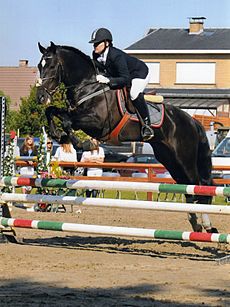
Andalusian horses have always been chosen for their athletic ability. In the 1600s, a writer named Cavendish said they were "so much faster than all other horses." In 1831, five-year-old horses were expected to gallop for 12 to 15 miles without stopping. By 1925, the Portuguese military expected horses to cover 25 miles (40 km) over rough land at a certain speed. They also had to gallop a flat course of 5 miles (8 km) carrying at least 154 pounds (70 kg). The Spanish military had similar high standards.
From the start, Andalusians have been used for both riding and driving (pulling carts). They were among the first horses used for classical dressage. They still compete in international dressage events today. At the 2002 World Equestrian Games, two Andalusians were on Spain's bronze medal-winning dressage team. This team later won the silver medal at the 2004 Summer Olympics. Today, breeders are choosing Andalusians more and more for their skill in classical dressage.
Historically, they were also used as stock horses. They were especially good at working with aggressive Iberian bulls. They were, and still are, known for their use in mounted bull fighting. Female horses (mares) were traditionally used for la trilla. This was a Spanish way of threshing grain, done until the 1960s. Mares, some pregnant or with foals, spent full days trotting over the grain. This was a traditional farm practice. It also tested the endurance and willingness of the motherly Andalusian lines.
Today, Andalusians are also used for show jumping, western pleasure, and other horse show events. The current Traveler, the mascot of the University of Southern California, is an Andalusian. The Andalusian horse looks very dramatic. It has an arched neck, strong muscles, and energetic gaits. This makes it a popular breed for movies. They are often seen in historical and fantasy films. Andalusians have been in movies like Gladiator, Interview with the Vampire, and Braveheart. They have also appeared in fantasy movies like The Lord of the Rings film trilogy and The Chronicles of Narnia: The Lion, the Witch and the Wardrobe. In 2006, a rearing Andalusian stallion was made into the world's largest bronze horse statue. It is 36 feet (11 meters) high. The statue is in El Paso, Texas.
See also
 In Spanish: Caballo andaluz para niños
In Spanish: Caballo andaluz para niños


